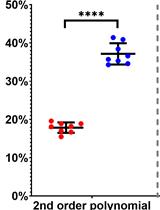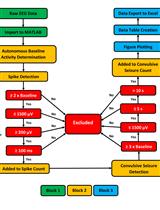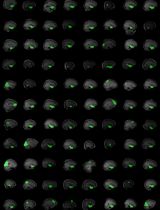- EN - English
- CN - 中文
Protocol to Quantitatively Assess the Structural Integrity of Perineuronal Nets ex vivo
体外定量分析神经元周围基质网的结构完整性方法
发布: 2019年05月20日第9卷第10期 DOI: 10.21769/BioProtoc.3234 浏览次数: 6777
评审: Arnau Busquets-GarciaMarta MiquelJoshua Brumberg
Abstract
Perineuronal nets (PNNs) are extracellular matrix assemblies of highly negatively charged proteoglycans that wrap around fast-spiking parvalbumin (PV) expressing interneurons in the cerebral cortex. PNNs play important roles in neuronal plasticity and modulate biophysical properties of the enclosed interneurons. Various central nervous system diseases including schizophrenia, Alzheimer disease and epilepsy present with qualitative alteration in PNNs, however prior studies failed to quantitatively assess such changes at single PNN level and correlate them with functional changes in disease. We describe a method to quantify the structural integrity of PNNs using high magnification image analysis of Wisteria Floribunda Agglutinin (WFA)-labeled PNNs in combination with cell-type-specific marker such as PV and NeuN. A polyline intensity profile of WFA along the entire perimeter of cell shows alternate segments with and without WFA labeling, indicating the intact chondroitin sulfate proteoglycan (CSPG) and holes of PNN respectively. This line intensity profile defines CSPG peaks, where intact PNN is present, and CSPG valleys (holes) where the PNN is missing. The average number of peaks reflect the integrity of the lattice assembly of PNN. The average size of PNN holes can be readily computed using image analysis software. Furthermore, degradation of PNNs using a bacterial-derived enzyme, Chondroitinase ABC (ChABC), allows to experimentally manipulate PNNs in situ brain slices during which biophysical properties can be assessed by patch-clamp recordings. We describe optimized experimental parameters to degrade PNNs in brain slices before as well as during recordings to study the possible change in function in real time. Our protocols provide effective and appropriate methods to modulate and quantify the PNN’s experimental manipulations.
Keywords: Perineuronal nets (神经元周围基质网)Background
The extracellular spaces of the central nervous system are filled by an amorphous interstitial matrix that is composed of dense network of proteoglycans, hyaluronic acid (HA), tenascins and link proteins, and is contiguous with well-organized lattice-like structures called PNNs that enclose the somata, axons and dendrites of PV expressing interneurons in the cerebral cortex (Härtig et al., 1999). The lattice of PNNs is composed of chondroitin sulfate proteoglycans (CSPGs), HA, tenascins, various link proteins (Deepa et al., 2006), etc. Owing to the high density of sulfated proteoglycans, PNNs are highly negatively charged (Morawski et al., 2015). The development of PNN coincides with the closure of ocular dominance critical period and studies have shown reinstatement of ocular dominance plasticity upon removal of the PNNs thereby suggesting inhibitory role of PNNs on neuronal plasticity (Pizzorusso et al., 2002). PNNs are also suggested to modulate the biophysical properties PV interneurons (Balmer, 2016, Favuzzi et al., 2017, Tewari et al., 2018), and are prone to degradation by ECM remodeling enzymes. Most notably, under pathological conditions including epilepsy (McRae et al., 2012, Rankin-Gee et al., 2015, Dubey et al., 2017, Tewari et al., 2018, Patel et al., 2019), schizophrenia and Alzheimer disease (Testa et al., 2018) ECM remodeling is common.
One of the major challenges in reporting on the status of PNNs is the quantification of the structural integrity of their lattice-like assembly. Essentially all published studies use the CSPG binding lectin, WFA, as non-specific PNN marker to visualize PNNs, and use WFA intensity to quantify the overall CSPG levels without detailed analysis of individual PNN’s architecture (Slaker et al., 2015 and 2016, Lensjø et al., 2017, Ueno et al., 2018). We developed a method to quantify the structural integrity of individual PNNs using high-magnification fluorescence imaging. This method also minimizes the errors due to procedure-related variations in the WFA intensity. After acquiring multichannel high magnification images (40x objective lens with 5 digital zoom) of individual PNNs, a polyline is drawn around the periphery of the cell. The fluorescence intensity of WFA along this line shows a discrete pattern of peaks separated by low-intensity valleys. Each peak represents the continuous CSPG and the gap between the two consecutive peaks represent a hole in the PNN (Tewari et al., 2018). The average number of peaks and average width of holes can be derived from the WFA intensity data points and are reflective of the PNN’s structural integrity. The peaks in the line profile can be counted manually or by using clampfit program (Molecular Devices).
A vast majority of studies, which explore the function of PNNs and their influence on the neuronal physiology, use ChABC, which is a bacterial enzyme that cleaves the chondroitin sulfate side chains thereby dismantling the PNN assembly (Dityatev et al., 2007, Balmer, 2016, Testa et al., 2018). The most common approach in such studies involves degradation of PNN in-vivo/in-situ brain slices/primary cultures and studying the function afterward by comparing two different populations of samples. However, it would be advantageous to record from PNN bearing neurons during the real-time degradation of PNNs to evaluate the physiological role of PNN on neuronal function. Such studies are largely absent in the literature. Here, we report two variants of experimental PNN degradation in the brain slices, which reliably degrade PNNs to allow studying their function. The first variant includes degradation of PNNs by incubating brain slices with ChABC in an incubation chamber followed by performing experiments to compare their properties with non-treated controls. The other variant is to study the baseline physiology in the presence of intact PNNs followed by superfusing ChABC solution and recording the functional activity during and after PNN depletion in the experimental set-up. Both the variants involve controlled degradation of PNNs and identifiable traces of degraded PNNs around the cells can be observed to confirm the presence/absence of PNNs on the experimental cell/tissue after post-experimental WFA staining of the samples. These methods provide unparalleled advantages to study the physiological functions associate with the PNNs.
Materials and Reagents
Materials
- PNN degradation in brain slices outside experimental setup
- Carbogen inlet and outlet needles (BD PrecisionGlide needle, catalog number: 305198)
- Perfusion Tubes (Becton Dickinson, PE-160, catalog number: 427431)
- Carbogen bubbling tubes (Fisher Scientific, Tygon, catalog number: S3 E-3603)
- Multichannel splitter (Luner valve assortment, catalog number: WPI-14055)
- Transfer pipettes (Fisher brand, catalog number: 13-711-7M)
- Glass Petri dish (Cole-Parmer Instrument, catalog number: EW-34551-06)
- Polystyrene foam (from any commercial source)
- PNN degradation in brain slices in experimental setup
- 15 ml tube (Falcon, catalog number: 352097)
- Thin perfusion lines (PVC pump tubes-1.52 mm ID, catalog number: 116-0549-19)
- Bubbling tubes (Fisher Scientific, Tygon, catalog number: S3 E-3603)
- Perfusion Tubes (Becton Dickinson, PE-160, catalog number: 427431)
- PNN’s structural integrity analysis
- High magnification (40 x 5 or higher) images of WFA with PV or NeuN
- High magnification (40 x 5 or higher) images of WFA with PV or NeuN
- WFA staining of brain slices
- 24-well plate (Falcon, catalog number: 35-3226)
- Paint Brush (Any fine tipped clean brush)
- Coverslips (Fisher Finest, catalog number: 12-548-5M)
- Glass slide (Micro slides, VWR, catalog number: 48311-703)
- Mounting medium (Thermo Fisher, Invitrogen, catalog number: S36936)
- Marker (Lab marker, VWR, catalog number: 52877-310)
- Transfer pipettes (Fisher brand, catalog number: 13711-7M)
Reagents
- ChABC (Sigma-Aldrich, catalog number: C3667-10U)
- Bovine serum albumin (BSA) (Sigma-Aldrich, catalog number: A8806-1G)
- 4% Paraformaldehyde (PFA) (Electron Microscopy Science, catalog number: 15714-S)
- PBS (Fisher Bioreagent, catalog number: BP661-10)
- Biotinylated Wisteria Floribunda Agglutinin/Lectin (WFA/WFL) (Vector Laboratories, catalog number: B-1355)
- Streptavidin, Alexa FluorTM 555 Conjugate (Thermo Fisher, Invitrogen, catalog number: S32355)
- 4',6-Diamidino-2-Phenylindole, Dihydrochloride (DAPI) (Thermo Fisher, Life Tech, catalog number: D1306)
- Mounting medium (Thermo Fisher, Invitrogen, catalog number: S36936)
- Dimethyl sulfoxide (DMSO) (Sigma-Aldrich, catalog number: D8418)
- ChABC (see Recipes)
- PBS (see Recipes)
- 4% PFA (see Recipes)
- ACSF (standard ringer’s ACSF for acute brain slices) (Papouin and Haydon, 2018, Tewari et al., 2018) (see Recipes)
- DAPI stock (see Recipes)
Equipment
- Measurement pipettes (Gilson, catalog number: F123602)
- Timer (from any commercial source)
- Sterile empty glass vials, 30 ml (such as Hospire, catalog number: 5816-31)
- Slice incubation assembly: assemble as shown in Figures 2B-2D
- Bath heater (Fisher Scientific, model: Isotemp 205)
- Peristaltic Perfusion pump (Gilson, model: mini-plus 3)
- In-line heater (Warner instrument, catalog number: TC324B)
- High resolution imaging microscope, such as Confocal microscope (Nikon Elements)
- 95% O2/5% CO2 tank (such as AirGas)
- -20 °C freezer (such as Norlake)
Software
- Nikon NIS-Elements
- Nikon NIS-Elements AR analysis
- (Optional) Clampfit (Molecular Devices)
- (Optional) Microsoft Excel/Origin (OriginLab)
Procedure
文章信息
版权信息
© 2019 The Authors; exclusive licensee Bio-protocol LLC.
如何引用
Tewari, B. P. and Sontheimer, H. (2019). Protocol to Quantitatively Assess the Structural Integrity of Perineuronal Nets ex vivo. Bio-protocol 9(10): e3234. DOI: 10.21769/BioProtoc.3234.
分类
神经科学 > 神经系统疾病 > 癫痫
神经科学 > 细胞机理 > 细胞外基质
细胞生物学 > 细胞染色 > 细胞外基质
您对这篇实验方法有问题吗?
在此处发布您的问题,我们将邀请本文作者来回答。同时,我们会将您的问题发布到Bio-protocol Exchange,以便寻求社区成员的帮助。
Share
Bluesky
X
Copy link












